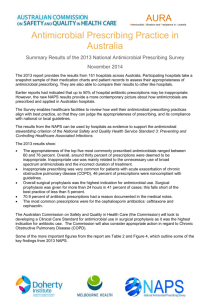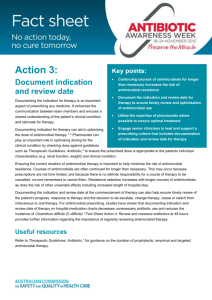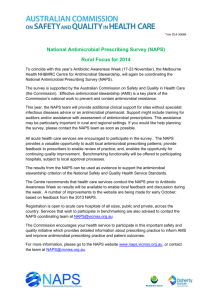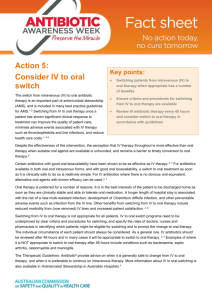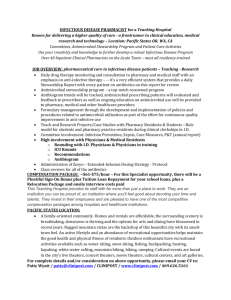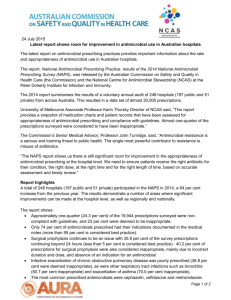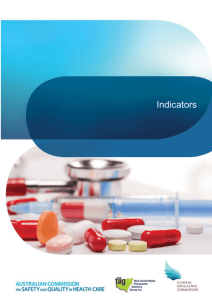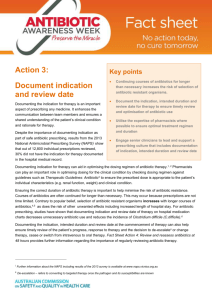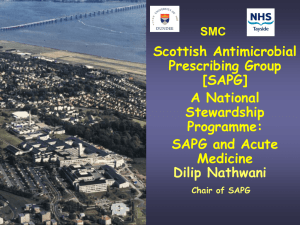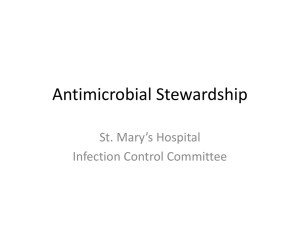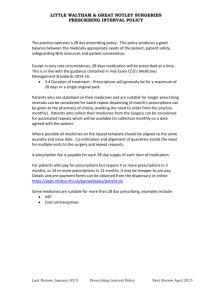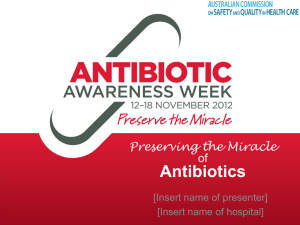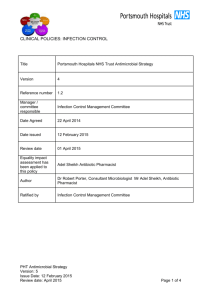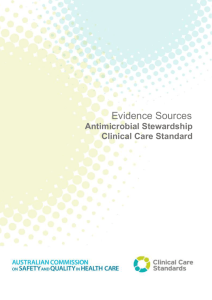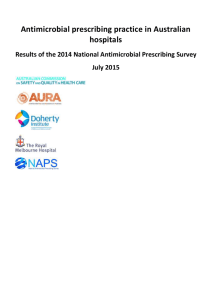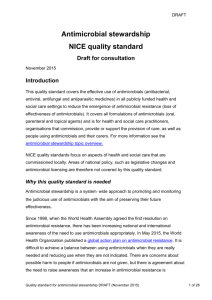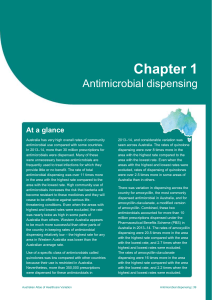New report provides insights into antibiotic prescribing in 151
advertisement
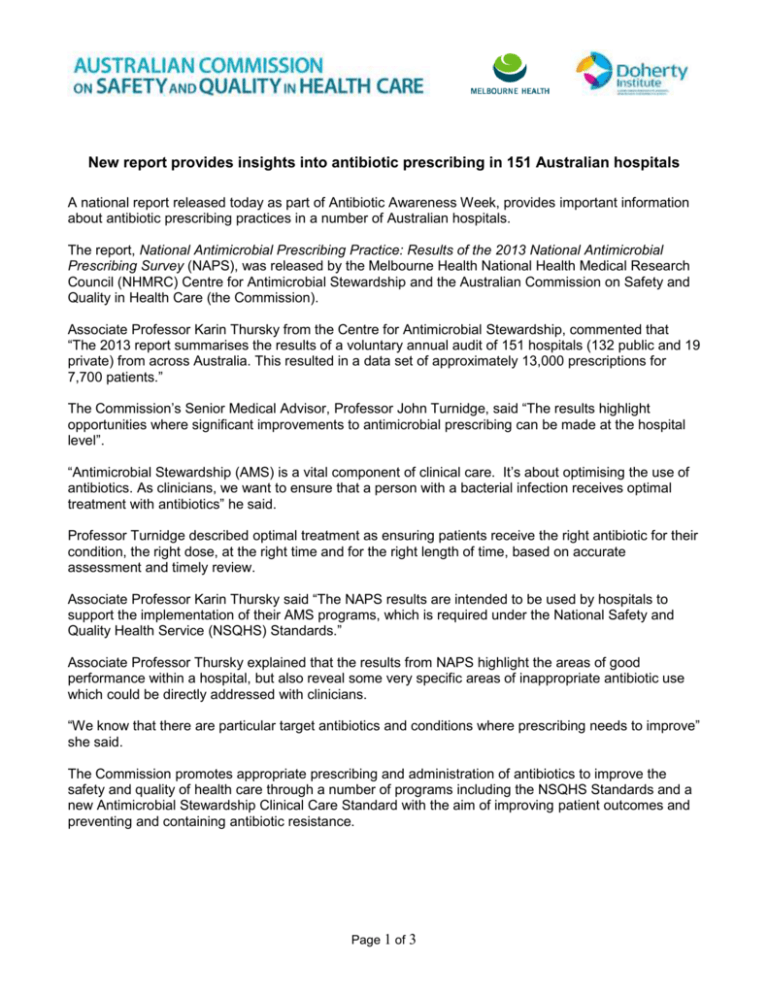
New report provides insights into antibiotic prescribing in 151 Australian hospitals A national report released today as part of Antibiotic Awareness Week, provides important information about antibiotic prescribing practices in a number of Australian hospitals. The report, National Antimicrobial Prescribing Practice: Results of the 2013 National Antimicrobial Prescribing Survey (NAPS), was released by the Melbourne Health National Health Medical Research Council (NHMRC) Centre for Antimicrobial Stewardship and the Australian Commission on Safety and Quality in Health Care (the Commission). Associate Professor Karin Thursky from the Centre for Antimicrobial Stewardship, commented that “The 2013 report summarises the results of a voluntary annual audit of 151 hospitals (132 public and 19 private) from across Australia. This resulted in a data set of approximately 13,000 prescriptions for 7,700 patients.” The Commission’s Senior Medical Advisor, Professor John Turnidge, said “The results highlight opportunities where significant improvements to antimicrobial prescribing can be made at the hospital level”. “Antimicrobial Stewardship (AMS) is a vital component of clinical care. It’s about optimising the use of antibiotics. As clinicians, we want to ensure that a person with a bacterial infection receives optimal treatment with antibiotics” he said. Professor Turnidge described optimal treatment as ensuring patients receive the right antibiotic for their condition, the right dose, at the right time and for the right length of time, based on accurate assessment and timely review. Associate Professor Karin Thursky said “The NAPS results are intended to be used by hospitals to support the implementation of their AMS programs, which is required under the National Safety and Quality Health Service (NSQHS) Standards.” Associate Professor Thursky explained that the results from NAPS highlight the areas of good performance within a hospital, but also reveal some very specific areas of inappropriate antibiotic use which could be directly addressed with clinicians. “We know that there are particular target antibiotics and conditions where prescribing needs to improve” she said. The Commission promotes appropriate prescribing and administration of antibiotics to improve the safety and quality of health care through a number of programs including the NSQHS Standards and a new Antimicrobial Stewardship Clinical Care Standard with the aim of improving patient outcomes and preventing and containing antibiotic resistance. Page 1 of 3 Highlights from National Antimicrobial Prescribing Practice: Results of the 2013 National NAPS The 2013 report provides the results from 151 hospitals across Australia. Participating hospitals take a snapshot sample of their medication charts and patient records to assess their appropriateness of antimicrobial prescribing. They are also able to compare their results to other like hospitals. Earlier reports had indicated that up to 50% of hospital antibiotic prescriptions may be inappropriate. However, the new NAPS results provide a more contemporary picture about how antimicrobials are prescribed and applied in Australian hospitals. The 2013 results show: The appropriateness of the top five most commonly prescribed antimicrobials ranged between 60 and 76 percent. Overall, around thirty percent of prescriptions were deemed to be inappropriate. Inappropriate use was mainly related to the unnecessary use of broad spectrum antimicrobials and the incorrect duration of treatment. Inappropriate prescribing was very common for patients with acute exacerbation of chronic obstructive pulmonary disease (COPD), 46 percent of prescriptions were noncompliant with guidelines. Overall surgical prophylaxis was the highest indication for antimicrobial use. Surgical prophylaxis was given for more than 24 hours in 41 percent of cases; this falls short of the best practice of less than 5 percent. 71 percent of antibiotic prescriptions had a reason documented in the medical notes. The most common prescriptions were for the cephalosporin antibiotics: ceftriaxone and cephazolin. The Commission will look to develop Clinical Care Standards for COPD and Surgical Prophylaxis. Australian Commission on Safety and Quality in Health Care The Commission is the lead agency for the development and coordination of national improvements in safety and quality in health care across Australia. The Commission aims to support health care professionals, organisations and policy makers who work with patients and carers. The Commission has commenced a major program of activities through its Antimicrobial Usage and Resistance Surveillance (AURA) Project, which will result in the establishment of a national AMR and AU Surveillance System. Another complementary initiative of the Commission is the development and implementation of the Clinical Care Standard for Antimicrobial Stewardship for use by individual prescriber health services and the patients. Melbourne Health National Health Medical Research Council (NHMRC) Centre for Antimicrobial Stewardship The Melbourne Health group have has just been awarded a $2.5 million NHMRC grant to set up the first National Centre for Antimicrobial Stewardship, working across the human and animal sector. Page 2 of 3 MEDIA INQUIRIES Lisa Parcsi, Australian Commission on Safety and Quality in Health Care (02) 9126 3600 or lisa.parcsi@safetyandquality.gov.au Nicky Webster, Public Affairs Director, Melbourne Health Mobile: 0408 503 180 or Nicky.Webster@mh.org.au Dr Lucy Stackpool-Moore, The Doherty Institute for Infection and Immunity Mobile: 0414 448 253 or lucy.stackpoolmoore@unimelb.edu.au NAPS was funded by the NHMRC, with additional support from the Australian Commission on Safety and Quality in Health Care, through the AURA Project. Page 3 of 3
